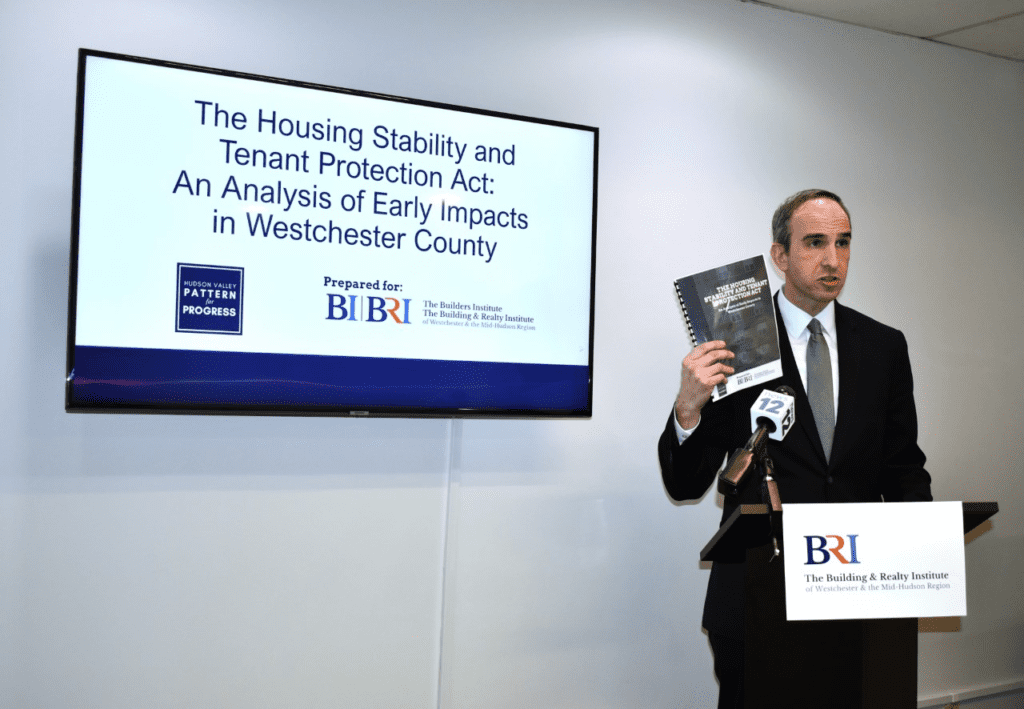
The Building and Realty Institute (BRI), recently released a new study, The Housing Stability and Tenant Protection Act: An Analysis of Early Impacts in Westchester County. The study reviews thepreliminary impacts of the 2019 Housing Stability and Tenant Protection Act (HSTPA) law in the real estate market within Westchester County.
Commissioned by the BRI, the study was conducted by nonprofit group Hudson Valley Pattern for Progress. The BRI, which counts among its members rent-stabilized and market-rate property owners, managing agents, commercial and residential lenders, and others, requested an objective and data-driven analysis of how the real estate market has changed since 2019. The study was completed in 2022.
Among other reforms, HSTPA changed a number of programs whereby property owners with rent-stabilized units could increase rents on new or renewing tenants. A previous vacancy bonus, which allowed landlords to add a fixed percentage to the rent when there is a change in tenant to help pay for renovations, had been eliminated entirely. Programs related to Major Capital Improvements (MCIs) like replacing a boiler or renovating an outdated elevator or Individual Apartment Improvements (IAIs) like repairing major wear and tear or replacing outdated appliances or fixtures were both greatly reduced in terms of the money that could be recouped and the period of time that such reimbursements needed to be spread out over.
The findings in this report suggest that there may indeed be some unintended consequences of HSTPA that may prove detrimental to both property owners and tenants. Key findings include:
- There has been a measurable decrease in the number of MCI applications since HSTPA became law
- There has been a decrease in the annual dollar amount on repairs and maintenance in rent-stabilized apartments.
- Allowable rent increases in Westchester for rent-stabilized buildings have not kept up with the rate of inflation.
- Buildings with low-rent units may have a more difficult time recouping the costs of an MCI
“The data collected for this study found a decrease in the number of applications for the maintenance and upkeep of buildings that are subject to HSTPA in Westchester County,” Pattern for Progress CEO Adam Bosch said. “These data need to be collected and tracked in future years to understand whether that decrease in applications is an effect of the law, an effect of the Covid-19 pandemic, or a combination of both. Our study will allow organizations like the BRI to track those changes over time to make fact-based conclusions about HSTPA and its impacts on renters and building owners. To help in that effort, the state Division of Homes and Community Renewal should post MCI applications, approvals and other data in a public portal to improve tracking and accountability for all.”
“Since Albany revised the rent-stabilization laws, we’ve heard from numerous property owners that the sweeping changes to the Individual Apartment Improvements and Major Capital Improvement programs had made it financially feasible to do much more than patch over renovation and repair issues,” BRI CEO Tim Foley said. “We turned to Hudson Valley Pattern for Progress to provide unbiased, rigorous research and careful analysis to determine whether these were temporary growing pains or the beginning of trends in need of correction. We believe their report gives both policymakers and advocates a lot to consider on how we reach our shared goals of providing housing that is affordable, safe, stable, and dignified.”
To conduct the study objectively, Pattern employed a combination of qualitative and quantitative research methods. In addition to interviews with various stakeholders, including building owners, housing advocates, housing lenders, and others, Pattern captured the potential quantitative impacts of HSTPA through an analysis of historic WRGB rent increases compared to the rate of inflation, an evaluation of changes to the IAI and MCI programs, an analysis of applications and orders under the MCI program before and after the legislation was passed, and a review of annual income and expense reports.
The primary limitations of this study are the short amount of time that has passed since HSTPA was adopted in 2019, the concurrent timing of Covid-19 pandemic with the passage of HSTPA which affected tenants, building owners, and the economy at large, and, in some cases, the quality of data available.
The Building and Realty Institute of Westchester and the Mid-Hudson Region (BRI), based in Armonk, has more than 1,800 members in fourteen counties of New York State, including home builders, commercial builders, renovators, property managing agents, co-op and condo boards, and owners of multifamily apartment buildings in many communities, as well as suppliers and service providers with a special focus on real estate. The BRI’s mission is to improve the relationships among builders and real estate business owners to the mutual advantage of the industry. For additional information, please visit https://www.buildersinstitute.org.





